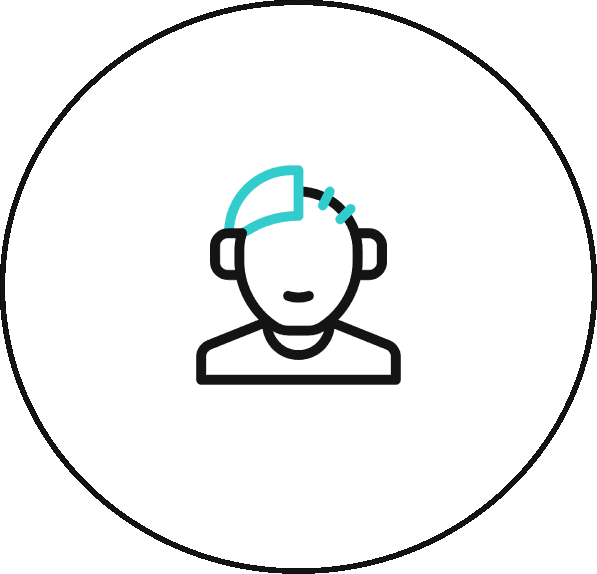Credle Cap
Credle Cap![]()
What is Cradle Cap?
Cradle Cap manifests as scaly, yellowish patches or crusts on infants’ scalps, akin to seborrheic dermatitis in adults. It typically emerges in the first few months post-birth, affecting infants aged one to three months. While it resembles adult seborrheic dermatitis, Cradle Cap rarely induces itching. However, the thick scales and crusts can be challenging to remove, causing distress to infants.
Causes of Cradle Cap:
- Excessive Sebaceous Gland Activity: Excess sebum can trap old skin cells, causing flakes.
- Fungal Growth: Malassezia fungus present on the skin can degrade sebum, triggering Cradle Cap, especially in susceptible infants.
Should You Be Concerned About Cradle Cap:
Typically, Cradle Cap poses no significant threat and resolves on its own. It isn’t contagious and isn’t linked to poor hygiene. However, the persistent scaling and crust formation can discomfort babies..
Treatment for Cradle Cap
While Cradle Cap often resolves spontaneously, mild cases may benefit from simple interventions:
- Topical Steroids: In severe cases, topical steroids can reduce scalp inflammation.
- Medicated Shampoos: Anti-dandruff shampoos or those containing ketoconazole may alleviate symptoms, especially if fungal infection is suspected.
Credle Cap![]()
![]()
![]()
![]()
![]()
Prevention of Cradle Cap
Preventing Cradle Cap involves:
- Regular scalp washing with mild baby shampoo.
- Using soft brushes to remove scales.
- Using medicated shampoos as advised by Dermatologist.
When to Consult a Dermatologist
If Cradle Cap persists despite home remedies or worsens, consult a Dermatologist. Signs of worsening include itching, swelling, bleeding, or rash spreading to the face and neck.


Credle Cap![]()
![]()
![]()
![]()
![]()
Conclusion
Cradle Cap, though common and usually benign, can cause discomfort for infants and concern for caregivers. By understanding its causes, symptoms, and management strategies, caregivers can effectively navigate Cradle Cap, ensuring the well-being of their little ones.
Why Choose Us?


Premier Surgeons: Expert alumni from AIIMS Delhi with 10+ years of experience.


Maximum Viability: Optimize graft survival with cutting-edge advanced Technology (Realtime Bio- Enhanced FUE)


Natural Hairline Design: Achieve the most natural hairline with 3000+ success stories.


Uncompromised Safety: 100% doctor-led surgeries with strict safety protocols.
Credle Cap![]()
![]()
![]()
![]()
![]()
Frequently Asked Questions
What is cradle cap?
It is a very commonly occurring condition in infants where there are thick, crusty, or greasy patches formed on the skin of the scalp; it’s actually a sort of seborrheic dermatitis and typically shows up in the first weeks of life.
What causes cradle cap?
The exact cause of cradle cap is unknown, but it is probably related to overactive sebaceous glands in the skin of the scalp. It has been suggested that the sebaceous glands are probably responding to maternal hormones still circulating through the infant’s blood.
Is cradle cap harmful to my baby?
Cradle cap is generally considered to be a harmless condition and does not appear to create any discomfort for the baby. It is a benign condition that mostly resolves on its own within a few months.
How do I treat cradle cap?
You can treat cradle cap by gently washing your baby’s scalp using mild shampoo; then you scrub off the scales using a soft brush. In more resistant cases, the pediatrician may advise using some baby oil or a medicated shampoo.
For the treatment of cradle cap, should I take my baby to the doctor?
Most of the time, the situation will not require the child to see a doctor. If something is noticed to be wrong—like cradle cap extending beyond the scalp, turning red and inflamed—or persists for a long time despite treatment at home, make sure to talk to the pediatrician.
Can cradle cap be prevented?
Although it can’t be completely prevented, a clean and dry scalp for the baby might help intervals of less occurrence. It is also advised to avoid the use of harsh shampoos and products that may cause irritation to the skin.
Does cradle cap spread to other parts of the body?
Yes. The condition, at times, can spread to the face, neck, and diaper area, featuring red, scaly patches. This atypical presentation of disease is still generally non-threatening.
Reach Out for a Hair Transformation Today!
Contact Us.
Delhi: C-26, First Floor, Greater Kailash 1, New Delhi, 110048, India
Bhubaneswar: 2nd Floor, D 1 Square , Nandan Kanan Road , KIIT Square, Patia, Bhubaneswar, Odisha 751024
Uttarakhand: Gularbhoj Rd, near The Royal Gym, Dineshpur, Gurunanakpur, Uttarakhand 263160
Chennai: 39/2, RK Shanmugam Salai, Goutham Colony, K. K. Nagar, Chennai, Tamil Nadu 600078




